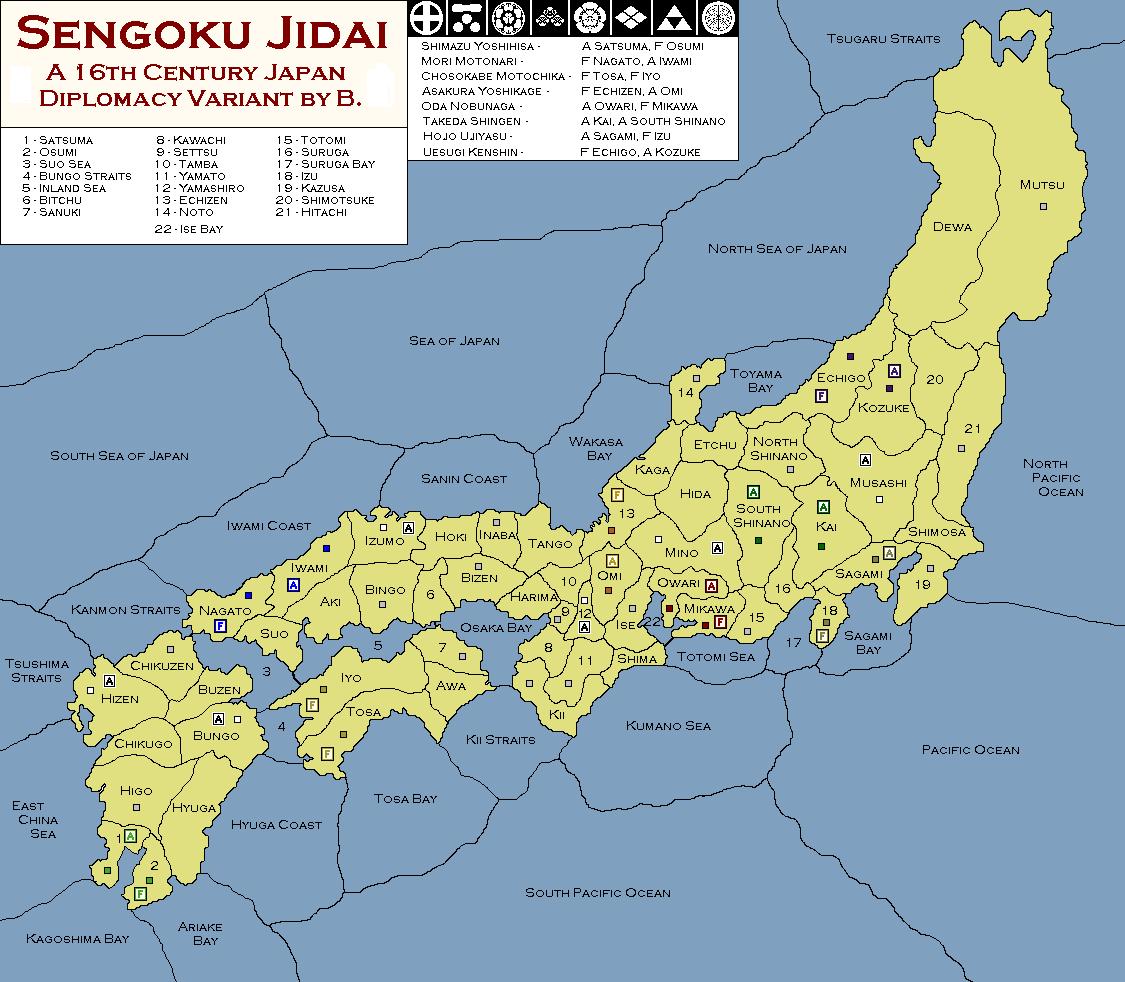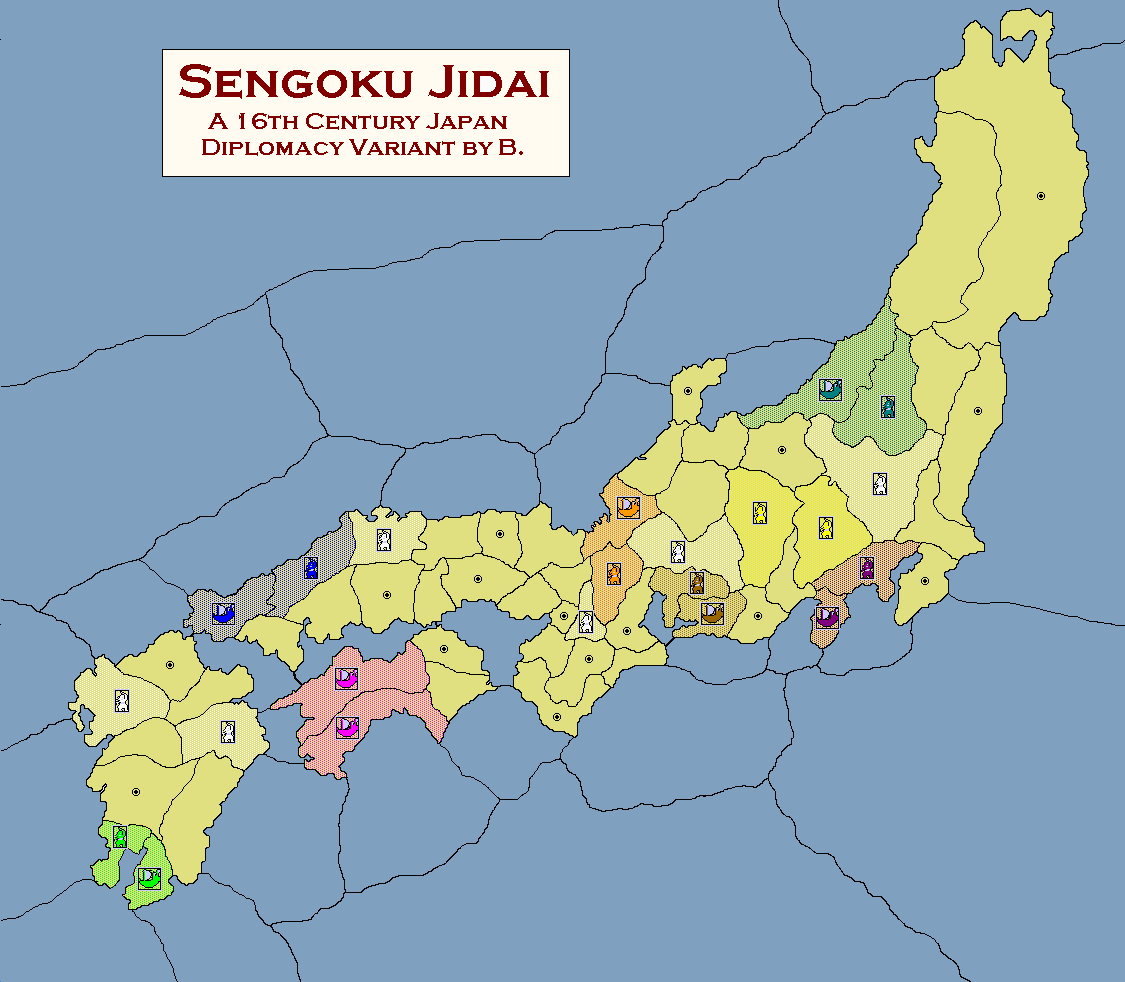Difference between revisions of "Sengoku"
Former.trout (talk | contribs) (New page: Sengoku Jidai Variant Rules, Version 1.0. <br> [http://www.geocities.com/nairenvorbeck/files Homepage:] === Variant Description: === The Sengoku Jidai Variant is a historical trans...) |
Former.trout (talk | contribs) |
||
| Line 3: | Line 3: | ||
| + | [[Image:Sengoku_Jidai.jpg|center|]] | ||
| Line 21: | Line 22: | ||
Bitchu and Sanuki are considered land contiguous, as are Nagato and Chikuzen, Shima and Mikawa, and Iyo and Suo, though they appear separated by water on the map. Both Armies and Fleets may cross from one of these territories directly to the other. Movement by fleets through the surrounding sea zones is unaffected. Two dark borders indicate these "bridges" on the map. | Bitchu and Sanuki are considered land contiguous, as are Nagato and Chikuzen, Shima and Mikawa, and Iyo and Suo, though they appear separated by water on the map. Both Armies and Fleets may cross from one of these territories directly to the other. Movement by fleets through the surrounding sea zones is unaffected. Two dark borders indicate these "bridges" on the map. | ||
| + | |||
| + | |||
| + | [[Image:Sengoku_Jidai_start.gif|center]] | ||
In addition to the 8 players of this variant, there are neutral territories, represented by White on the map. Each neutral territory is occupied by a neutral army that never does anything but hold. These armies may be supported by other players. They are disbanded immediately if dislodged, but rebuilt at the end of the year if the territory is not occupied. Treat neutral units like | In addition to the 8 players of this variant, there are neutral territories, represented by White on the map. Each neutral territory is occupied by a neutral army that never does anything but hold. These armies may be supported by other players. They are disbanded immediately if dislodged, but rebuilt at the end of the year if the territory is not occupied. Treat neutral units like | ||
Revision as of 00:07, 8 January 2008
Sengoku Jidai Variant Rules, Version 1.0.
Homepage:
Variant Description:
The Sengoku Jidai Variant is a historical transplant of Hasbro/Avalon Hill's Diplomacy to medieval Japan. The Sengoku Jidai Variant conforms to the standard rules of Hasbro/Avalon Hill's Diplomacy in most every way, with the few exceptions listed below. The standard rules are NOT copied here, and all players of the Sengoku Jidai Variant are assumed to own or expected to purchase the Rules of Diplomacy (or better yet, the full game) through Hasbro/AH, as I did.
Turns move from Spring to Fall just like standard Diplomacy, and the first turn is Spring 1570.
Abbreviations are often not at all what you might expect them to be because of the significant number of provinces that share the same first three letters (i.e. Chikugo, Chikuzen, Echigo, Echizen, Shimosa, Shimotsuke, Izumo, Izu, Yamashiro, Yamato, and all those that share their name with a body of water e.g. Totomi, Totomi Sea, Tosa, Tosa Bay etc. etc.) Be sure to check the names feature on Realpolitik.
Units may be built on any vacant supply center that you have held for a fall. (i.e. all SCs controlled by players are considered their "home supply centers" for the purpose of building units - [Chaos Builds].)
Bitchu and Sanuki are considered land contiguous, as are Nagato and Chikuzen, Shima and Mikawa, and Iyo and Suo, though they appear separated by water on the map. Both Armies and Fleets may cross from one of these territories directly to the other. Movement by fleets through the surrounding sea zones is unaffected. Two dark borders indicate these "bridges" on the map.
In addition to the 8 players of this variant, there are neutral territories, represented by White on the map. Each neutral territory is occupied by a neutral army that never does anything but hold. These armies may be supported by other players. They are disbanded immediately if dislodged, but rebuilt at the end of the year if the territory is not occupied. Treat neutral units like armies in Civil Disorder. Once occupied, the territory becomes a standard SC, and never reverts to a neutral again.
Victory is declared when one Daimyo has control of 12 SCs, or all other players concede defeat. If the players agree to a draw, the GM chooses a winner(Shogun), usually the player with the highest SC count, or at the GM's sole discretion if there is a tie for the highest SC count. There can only be one Shogun.
Have fun and welcome to 16th Century Japan!

